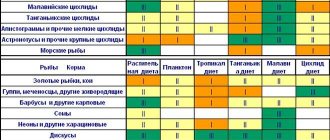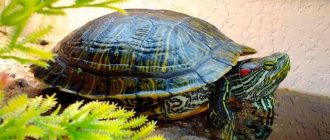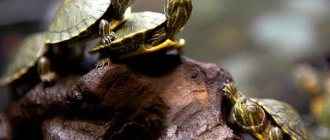In nature, red-eared turtles find a wide variety of food for themselves. They are omnivores. They can feed on fish, beetles, mollusks, crustaceans, water snails, algae, and coastal plants. The only danger is from “delicacies” found in garbage dumps near human habitation. Oddly enough, at home the risk of eating something harmful or poisonous is much higher than in the wild. Inexperienced owners offer their pets human food prepared with salt and spices, canned food, sweets, and industrial food intended for cats and dogs. Curious turtles try everything. As a result, disorders and poisoning are possible. But it is much more dangerous when unacceptable foods are included in the diet on an ongoing basis. An unbalanced diet leads to irreversible consequences. Therefore, at home you need to carefully monitor the nutrition of the red-eared turtle. What to feed red-eared turtles to keep them healthy and active?
Basic principles of feeding
The main requirements for a turtle's diet are balance and variety. Homemade food should be as close as possible to the natural food of the red-eared turtle. You cannot accustom her to one type of food.
In captivity, regularly receiving food without effort, the animal becomes picky. Choosing the most delicious morsels, he refuses other products necessary for proper digestion and growth. For example, receiving a portion of nutritious soft meat every day, the turtle refuses plant foods and shellfish in hard shells. Obesity is progressing rapidly. Rickets develops. Curvature of the spine is accompanied by pressure on vital organs. Without enough minerals, the shell softens and flakes off. Without receiving the proper load, the beak grows, which interferes with feeding. The quality of life of the animal leaves much to be desired. Its duration is reduced significantly. Attempts to improve the situation with the help of complex vitamin supplements often lead to hypervitaminosis, which brings even more trouble.
What to feed a red-eared turtle at home? It is necessary to create a varied, balanced menu that will meet the energy needs, age and physical activity of the pet. The diet should include plant and animal foods, vitamins and minerals. Part of the food should be hard (shells of mollusks and snails, sepia) so that the turtle can grind down the beak that grows on the jaw.
What to feed a land turtle at home
Turtles are classified as omnivores. What does a land turtle kept at home eat? It is advisable to include not only plant foods in the diet. Twice a week you should give a turtle kept at home snails, crickets, and worms. Your pet will happily eat fresh fruits, vegetables and berries: melons, apples, tomatoes, carrots, broccoli. Always balance your turtle's diet. Some of them prefer sweet fruits, which should be alternated with other foods to ensure that their diet is full of nutrients and minerals. Leafy greens are an excellent addition to this animal's diet.
Among the favorite delicacies of turtles are:
- small fish;
- crayfish;
- crickets.
It is advisable to buy turtle food at a pet store to supplement the diet with some vitamins that they lack in captivity.
Feed your pet turtles a plant-based diet:
- clover and dandelions;
- parsley and lettuce;
- carrots and cabbage;
- raspberries and grapes;
- apricots and plums;
- bananas, apples, oranges.
By using these tasty foods in your pet's diet, you can provide her with an ideal environment in your home.
We should not forget that the turtle needs to be fed dry food (sea kale, seeds, champignons, bran, dry yeast, etc.)
Feeding process
Reptiles feed in water, since saliva does not form in the mouth, and there is nothing to moisten the food with. In order to swallow food, the turtle needs to dive headfirst. Reptiles can swallow small prey immediately. They tear large pieces with their claws and beak. Most of it becomes unusable and the turtle cannot pick it up. Therefore, the food should be finely chopped. Many breeders place turtles in a separate container with warm water during feeding so that the water in the aquaterrarium is less polluted.
Products should always be fresh and at room temperature.
In a warm aquarium environment, food spoils quickly. Therefore, you cannot give the whole portion at once; it is better to offer one piece at a time.
How can you hand feed a red-eared turtle? Any pieces of solid food are suitable for taming, except ready-made dry food. The granule should get wet so that the turtle does not injure its oral cavity. The animal will not be able to take a slippery small lump of food from the hands without biting the owner’s finger. Red-eared turtles are active, strong and fast. You should remember this when giving your reptile a treat.
How long should you feed your red-eared slider? Food is usually offered within 15-30 minutes. During this time, the reptile can become sufficiently full. Remains of food must be removed from the aquaterrarium. If your turtle is active and appears healthy but refuses to eat, there is no need to continue feeding or replace the diet with a favorite treat. Most likely, there is no appetite due to lack of exercise. However, it is worth checking the temperature and quality of the water, as well as continuing to monitor the turtle.
In aquaterrariums with several inhabitants (especially those of different ages), competition should be limited. All pets should receive enough food during feeding time.
How many times should you feed your red-eared slider? Although turtles spend all their time searching for food, digging up the soil and turning over rocks at the bottom, they should only be fed once a day at the same time. It is advisable that it coincides with the period of greatest activity of the reptile. It must be borne in mind that digestion in cold-blooded animals is slow. Feeding is done several hours before bedtime so that the food has time to digest.
Specifics of the turtle menu depending on their species
Waterfowl turtles are often predators, so the basis of their diet is food of animal origin. If your aquarium contains a semi-aquatic or swamp reptile that prefers vegetarian food, the diet will be based on plant foods. In any case, the nutrition for a turtle must be balanced and varied so that the body of the domestic reptile fully receives all the necessary substances and microelements.
Features of the diet of turtles of different species:
- The red-eared turtle prefers fry, small fish with bones, insect larvae, chicken fillets, gammarus and shrimp. From plant foods you can give apples, lettuce and fresh cucumber slices.
- The amphibious turtle Trionics Chinese gladly eats beef liver, heart, lean fish, fry and small frogs. From plant foods, she will like fresh herbs and tomato slices.
- The European marsh turtle loves lean meat, fish with small bones and plant foods.
- The musk turtle prefers to eat algae, fish and aquatic insects.
Diet
How often should you feed your red-eared slider? Young and actively growing individuals are fed every day. Up to a year, protein must be present in the menu (60-70% of the total diet). Upon reaching the age of 2-3 years, growth slows down. The body's energy needs decrease. For an adult turtle, it is enough to eat a large meal once every two to three days. The amount of protein consumed is reduced to 40%. On fasting days, only small quantities of green food are offered.
Protein sources
The basis of the diet of a young turtle is low-fat fish. Raw fish contains an enzyme that selectively destroys and inactivates thiamine (vitamin B1). Therefore, before feeding the red-eared aquatic turtle, the fish is scalded or even kept in boiling water for eight to ten minutes. It is not recommended to cook fish for a long time, since long-term processing deprives it of most of its beneficial properties.
Is it possible to feed a red-eared turtle unpeeled fish? In nature, the reptile eats small fish, caught in proportion to its capabilities. Saltwater fish bought in a store have a backbone that is too powerful for a turtle's jaws to handle. Large bones are removed to prevent the pet from injuring the larynx or choking. Fish entrails may contain fragments and larvae of various parasites and should not be offered to the turtle. Only small river fish can be fed whole, remembering to scald them first.
Aquatic turtles happily eat all types of seafood: shrimp, squid, octopus, mussels, oysters, and crab meat. Shellfish should be offered with the shell.
Meat is a very nutritious food. It should be offered in small quantities and not every day. Beef, chicken, turkey, rabbit and horse meat are all types of lean meat that are suitable to feed red-eared turtles. How else can you diversify your diet? You can use the heart, liver, lung, and gizzards of birds.
Meat and offal are offered both raw and scalded.
Live foods are especially useful in the diet. In addition, hunting is an excellent activity to entertain a bored turtle, improve appetite and tone up in the autumn-winter period.
What can you feed red-eared turtles? Depending on the size of the turtle, you can use the following as live food:
- aquarium fish (livebeards, characins, barbs);
- snails (land snails, pond snails, mariza, coil, ampularia);
- insects (in the summer these can be beetles, grasshoppers, grasshoppers, hairless caterpillars, and throughout the year - mealworms, bloodworms, gammarus, daphnia, coretra);
- naked mice;
- frogs.
Diet of an adult turtle and small pets
The diet of an aquatic turtle should be combined - natural food combined with artificial food. Let's look at what foods can and cannot be given to aquarium reptiles.
Useful and harmful natural products for aquatic turtles:
- You can give low-fat river fish in crushed form with chopped bones. You should not feed turtles bony and fatty fish.
- You can feed live gammarus and small crustaceans.
- Shrimp and crabs are allowed to be fed raw.
- You should not feed turtles squid, although they love them very much.
- It is strictly forbidden to give reptiles the meat of terrestrial animals and factory-made meat products (sausage, canned food, etc.). The digestive system of reptiles does not digest such food.
- Occasionally you can treat your turtle to pieces of beef heart and liver. These foods provide the body with vitamin A.
- It is allowed to feed the reptile with food mice and frogs.
- From natural plant foods, turtles can be given carrots, lettuce, apple pulp, greens, sprouted oats and barley.
- Non-poisonous meadow plants, as well as algae and some types of aquatic plants can be introduced into the diet.
- Pieces of pear, watermelon, melon, banana, apricot and raspberry are served in limited quantities.
- You cannot give turtles citrus fruits, nuts, soybeans, beans, cabbage, bread, flour products, cereals, fish waste, dairy products, and chicken eggs.
- Foods high in phosphorus, strumogenic substances and oxalates are harmful to reptiles.
- With pleasure and benefit, turtles eat various insects and larvae living in the water. They can be fed barnacles, bloodworms, locusts, crickets, fly larvae, earthworms and moths. The insect must first be decapitated. Can be given dried, frozen, or live.
- Live and thawed mollusks, land snails, ampularia, marises, etc. are well absorbed by the reptile body. But it is better not to treat the turtle to slugs without shells.
Plant food
Throughout life, it is a necessary element of nutrition. With age, it becomes its basis. Vegetables and fruits are given in small pieces directly in the water. Grasses are fixed in small bunches (three to four stems) above the surface of the water. Various algae can be planted directly in the aquarium, protecting the roots and stems with decorative ceramics.
The list of permitted green feeds is very extensive:
- fruits (apple, pear, plum, apricot, peach, melon);
- vegetables (white and cauliflower, broccoli, carrots, zucchini, pumpkin, cucumbers, milk green peas and beans);
- herbs (lettuce, spinach, celery, dandelion, clover, sprouted oats);
- aquarium plants (spirogyra, anacharis, ceratopteris, hornwort, edogonium, common duckweed, pond algae, dried seaweed).
Vitamins and mineral supplements
Under natural conditions, the turtle eats small fish and shellfish along with bones and shells. This provides the body with building material for a strong shell and skeletal bones. Mineral supplements help bring home feeding of purified fish and meat closer to natural food: bone meal, crushed eggshells, pharmaceutical preparation of calcium gluconate or sulfate. The powder is usually mixed with soft food before feeding to red-eared turtles. You can dip pieces of meat or fish into the mineral mixture and offer the treat from your hands. Young animals should be given 5 g daily, adults – two to three times a week, 10 g of mineral supplements.
To compensate the red-eared turtle for the lack of sun, a UV lamp is placed in the aquaterrarium and the diet is enriched with vitamin D3, A, C, E. To do this, “Trivit”, “Tetravit” or other multivitamin preparations are added to the food once a week, three to four drops.
Pet stores offer complex vitamin and mineral supplements: Reptile Calcium, Reptile Multi-Vitamins, ReptoCal, ReptoLife, ReptoVit, Reptilife and others. For picky reptiles that won't accept food with additives, there is Nature's Reptile Vita-Spray for topical use. The turtle's skin and shell are sprayed with it every day. It affects bone tissue, being absorbed throughout the entire surface of the body.
Such drugs are given without a veterinarian's prescription, but strictly according to the instructions, in accordance with the weight and age of the turtle. Vitamin complexes designed for warm-blooded animals are strictly contraindicated.
You can compensate for the lack of chlorine ions by adding 0.5-1.5 liters of still mineral water to the aquaterrarium.
What is not recommended to include in the diet
The most dangerous foods for river turtles are from the human table, as well as food consumed by pets.
Never feed your reptiles the following types of food:
- vegetables;
- fruits;
- too fatty varieties of fish and meat.
You should also be especially careful when choosing insects and plants. Many types of them can be poisonous, while others can interfere with the normal process of calcium absorption or cause iodine deficiency.
If you follow all the necessary recommendations and nutritional tips, your pet will always be in a healthy state of mind. For him, the most important thing is a rich and balanced diet, and you can think through it yourself, the main thing is to first study its features.
Ready-made feed
Creating the right menu requires a competent approach. Daily food preparation (defrosting, scalding, removing bones, slicing), feeding and cleaning the aquarium itself takes a lot of time. To make caring for your pet easier, you can use industrial feed mixtures. Well-known manufacturers of ready-made diets for reptiles - WARDLEY (USA), TETRA (Germany), SERA (Germany) and Biodesign (Russia) - offer complex products developed by veterinarians that fully satisfy the body's needs. You can choose well-balanced food in all price categories.
The diets for young and adult turtles differ significantly in composition. Before feeding red-eared aquatic turtles, you need to carefully read the purpose and composition of the food. Baby food is rich in protein and has a strong, attractive smell. Diets for adult turtles consist of 70% plant ingredients and are almost odorless. An actively growing individual will not be able to fully develop while eating adult food, and will most likely refuse to eat it. A large turtle, on the contrary, will happily feast on “baby food”, acquiring excess weight and associated health problems.
How much to feed red-eared turtles with “baby” food is determined individually. Size cannot be a sign of age, since turtles grow very quickly under favorable artificial conditions. If the diameter of the shell increases evenly, then daily feeding and a protein diet are required. In the first year of life, the turtle doubles in size. The growth rate slows down over the next few years. Normally, the shell should increase by about two cm per year. If the stripes between the scutes on the carapace become very wide and light, it means that the turtle is overeating and it is time to switch it to an adult plant diet.
Canned food for turtle
Pampered pets often refuse pelleted food. Soft, fresh food tastes much better. You can prepare a delicious and aromatic combination food with your own hands. It will help save time on daily cooking for young animals.
Grind 300 g of vegetables (carrots, zucchini, pumpkin, cabbage, apples) and 300 g of seafood or fish in a blender. 300 ml of milk and four eggs are poured into the mixture. According to the instructions, gelatin is diluted in 300 ml of water. A few drops of Tetravit will balance the composition of the feed. The hardened mixture is hermetically sealed with a lid. It can be stored in the refrigerator for several days. Before feeding red-eared turtles, the product is warmed to room temperature. The amount of food is designed for approximately a week for two average individuals.
Dangerous products
Despite the fact that these reptiles are omnivorous and unpretentious, their capabilities are not limitless. You need to remember this when getting a red-eared turtle.
So. What should you not feed red-eared turtles? First of all, this is human food: sausages, canned food, dairy products, cheeses, flour products. You should not feed red-eared turtles just anything. The small amount of food they eat per day should bring maximum benefits for growth and proper development.
Foods and vitamins designed for fish, cats and dogs do not meet the needs of reptiles. They can cause severe disorders, and with constant use - irreversible consequences.
Fatty meats and fish will not benefit digestion. They are harmful to the turtle's stomach and liver. In addition, the fatty film can harm the health of the skin, eyes and shell, and spoil the water in the aquarium and the biofilter.
Among plant products, all types of citrus fruits and other sour fruits, spicy vegetables (onions, garlic), and spicy herbs are dangerous. Some types of algae (Elodea, Ambulia and Lagenandra) are toxic to reptiles.
Types of turtles
Herbivores
This large group of reptiles needs food of plant origin. Meat can be added to the feed in very small quantities, and the basis of the diet is vegetables, fruits and grass. The most common types of turtles used as pets are Central Asian and Mediterranean turtles.
Predatory
These reptiles eat meat, plant food serves as a snack and does not exceed 10% of the volume of food consumed. They need to be given seafood and lean fish as food. Almost all aquatic turtles are predators.
Most popular:
- Trionix;
- swamp;
- red-eared
The last two species feed on fish only at an early age. Adult turtles switch to mixed types of food.
Omnivores
Their diet consists of plants and meat in approximately a 1:1 ratio. Due to evolutionary features, this group most often includes land reptiles, as well as red-legged, adult red-eared and marsh reptiles.










